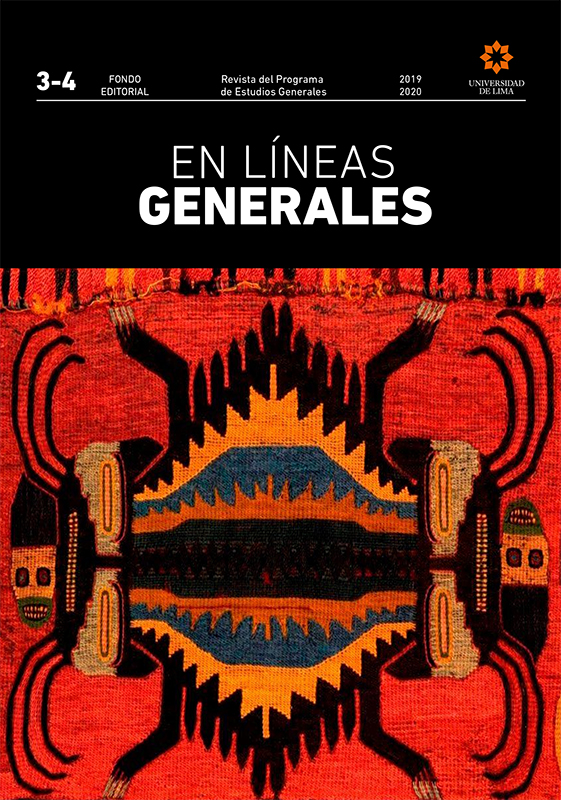The huachafa´'s cultural production
DOI:
https://doi.org/10.26439/en.lineas.generales2020.n3-4.5085Keywords:
cultural production, aesthetics, hybridization, mixed processesAbstract
Contemporary cultural production in our context is characterized by having multiple influences, which result in various final products, eclectic and, in manycases, perceived as inadequate. The terms chicha ohuachafo design attitudes, consumer goods, cultural products and even works of art, whose image refer to the mixed characteristics of our society. The combination of traditions, local characters, modernization impulses and the search for belonging to a global environment are some of the forces making the aforementioned products possible. When analyzing huachafo from both a formal and a social point of view, we aim to understand, through everyday events, cultural and artistic manifestation, which are the reasons and mechanisms behind these creations. There is an adaptation process to new situations, and the construction of our contemporary cities. The huachafo products are, on one side, a key to read who we are. On the other hand, they become part of our everydayness and in this dialogue, there could provoke the construction of a new identity: that of the contemporary Peruvian who “tiene de inga y tiene de mandinga”.
Downloads
References
Chuquiruna, O. (2009). Diseñando la ciudad. En S. Bedoya (Ed.), Coloquio Lo Cholo en el Perú. Migraciones y mixtura (pp. 165-172). Lima: Biblioteca Nacional del Perú.
Dreifuss Serrano, C. (19 de abril del 2010). 10 ideas sobre lo huachafo (desarrolladas) [mensaje en un blog]. Recuperado de http://arquitecturahuachafa.blogspot.pe/2010/04/10-ideas-sobre-lo-huachafo_14.html
Dreifuss Serrano, C. (2011a). Huaycán. A case study in spontaneous architecture. En Informality: Re-viewing Latin American cities. Cambridge, UK: CRASSH (The Centre for Research in the Arts, Social Sciences and Humanities).
Dreifuss Serrano, C. (2011b). L’estetica (del huachafo) nell’architettura contemporanea a Lima (tesis doctoral). Università degli Studi di Roma La Sapienza, Italia.
Gildemeister, A. (13 de abril del 2015). ¿Cuándo se huachafió el Perú? Lucidez. Recuperado de http://www.lucidez.pe/nacional/cuando-se-huachafio-el-peru/
Hildebrandt, C. (14 de febrero del 2010). Miota y la huachafería [mensaje en un blog]. Recuperado de http://bloghildebrandt.blogspot.pe/2010/02/miota-y-la-huachferia.html
Hildebrandt, M. (1994). Peruanismos. Lima: Biblioteca Nacional del Perú.
Knowlton, D. (13 de agosto del 2014). Huachafo, a key word in Peru. Cusco Eats. Recuperado de http://cuzcoeats.com/huachafo-a-key-word-in-peru/
Lucio Pezet, F. (1993). Del origen de las palabras y las frases: breviario de etimología histórica de palabras, locuciones y frases. Lima: Talleres Gráficos.
Manrique Sabogal, W. (23 de octubre del 2013). Atlas sonoro /6: Elige las palabras de Perú, Paraguay y República Dominicana [mensaje en un blog]. Recuperado de http://blogs.elpais.com/papelesperdidos/2013/10/atlassonoro-6-elige-las-palabras-de-peru-paraguay-y-republica-dominicana.html
Martuccelli, D. (2015). Lima y sus arenas. Poderes sociales y jerarquías culturales. Lima: Cauces Editores.
Moles, A. (1971). Psychologie du Kitsch. L’art du bonheur. París: Maison Mame.
Panfichi, A., y Portocarrero, F. (1995). Mundos interiores: Lima 1850-1950. Lima: Universidad del Pacífico, Centro de Investigación.
Parker, D. S. (1998). Idea of the middle class: white-collar workers and Peruvian society, 1900-1950. Pensilvania: The Pennsylvania State University Press.
Pinto Gamboa, W. (1979). Envés y reflexión de lo huachafo (Jorge Miota: vida y obra). Lima: Imprenta de la Universidad Mayor de San Marcos.
Rivera Martínez, E. (2003). Estampas de ocio, buen humor y reflexión. Lima: Universidad Nacional Mayor de San Marcos, Fondo Editorial.
Salazar Bondy, S. (2008). Lima la horrible. Concepción: Editorial Universidad de Concepción. (Trabajo original publicado en 1964).
Schwab, F. (1940). Lo huachafo como fenómeno social. Revista 3, 4, 16-22.
Vargas Llosa, M. (28 de agosto de 1983). ¿Un champancito, hermanito? El Comercio.
Velarde, H. (1966). Contribución al estudio de la huachafería en el arte. En Obras completas (II) (pp. 393-396). Lima: Francisco Moncloa Editores.


